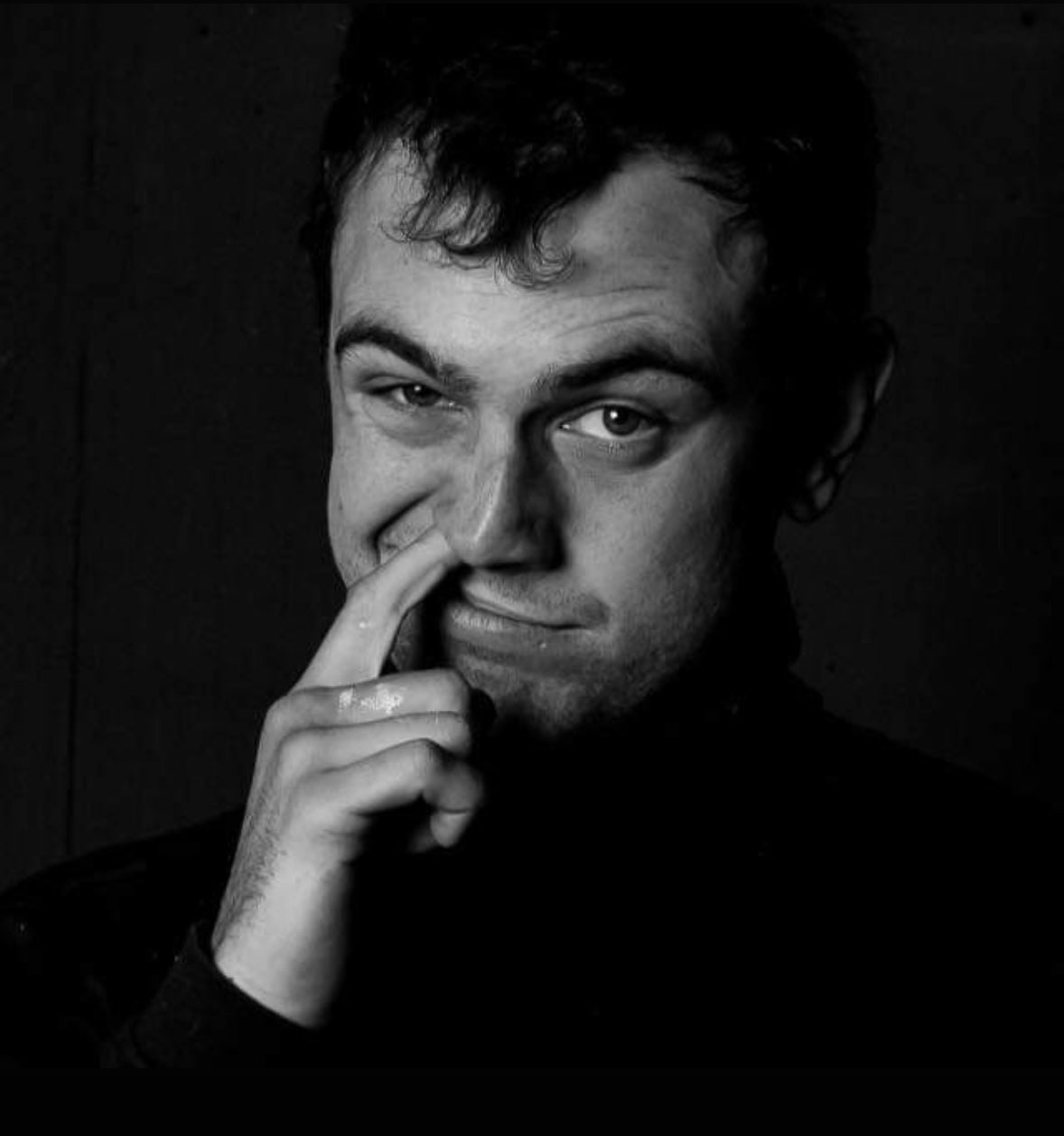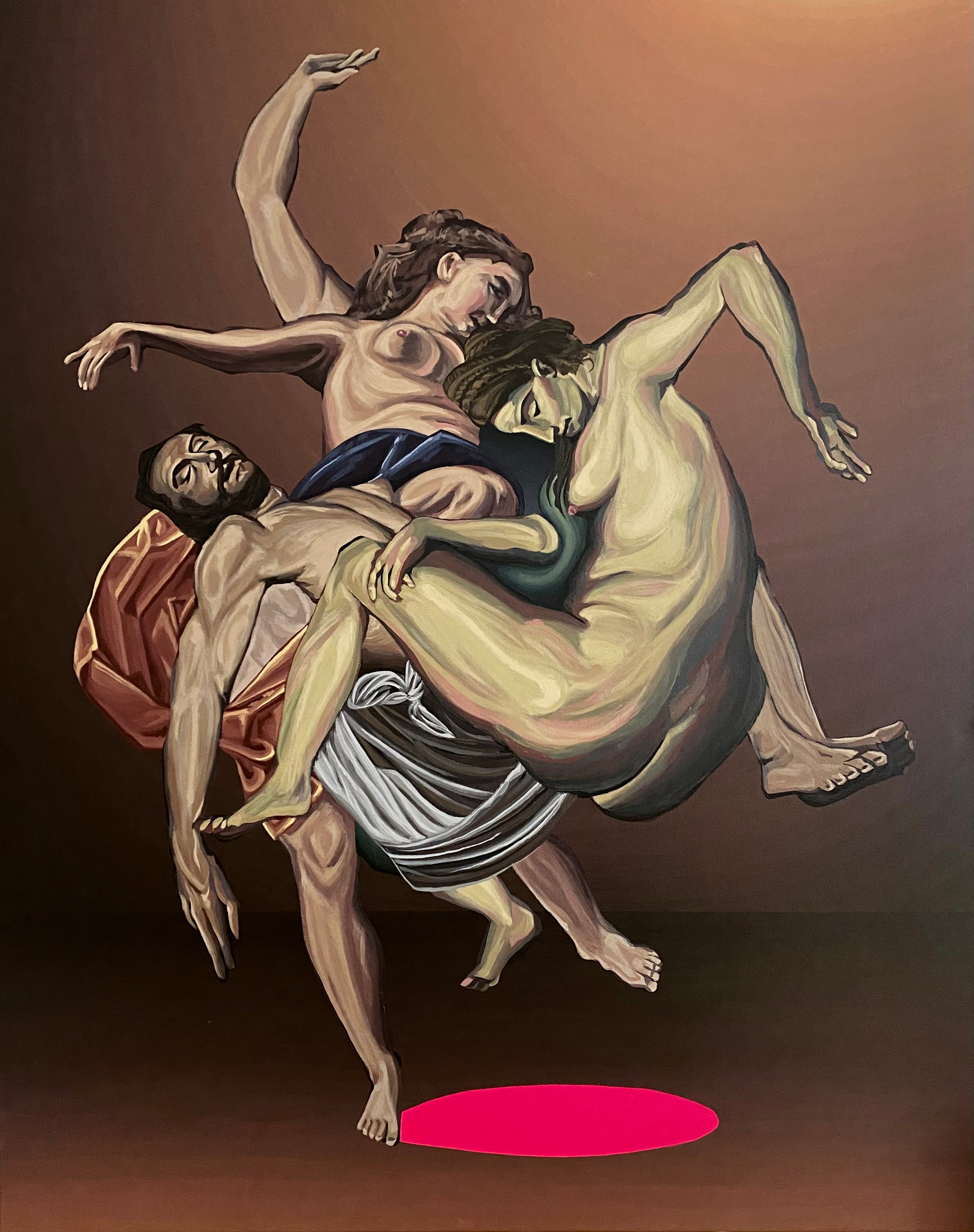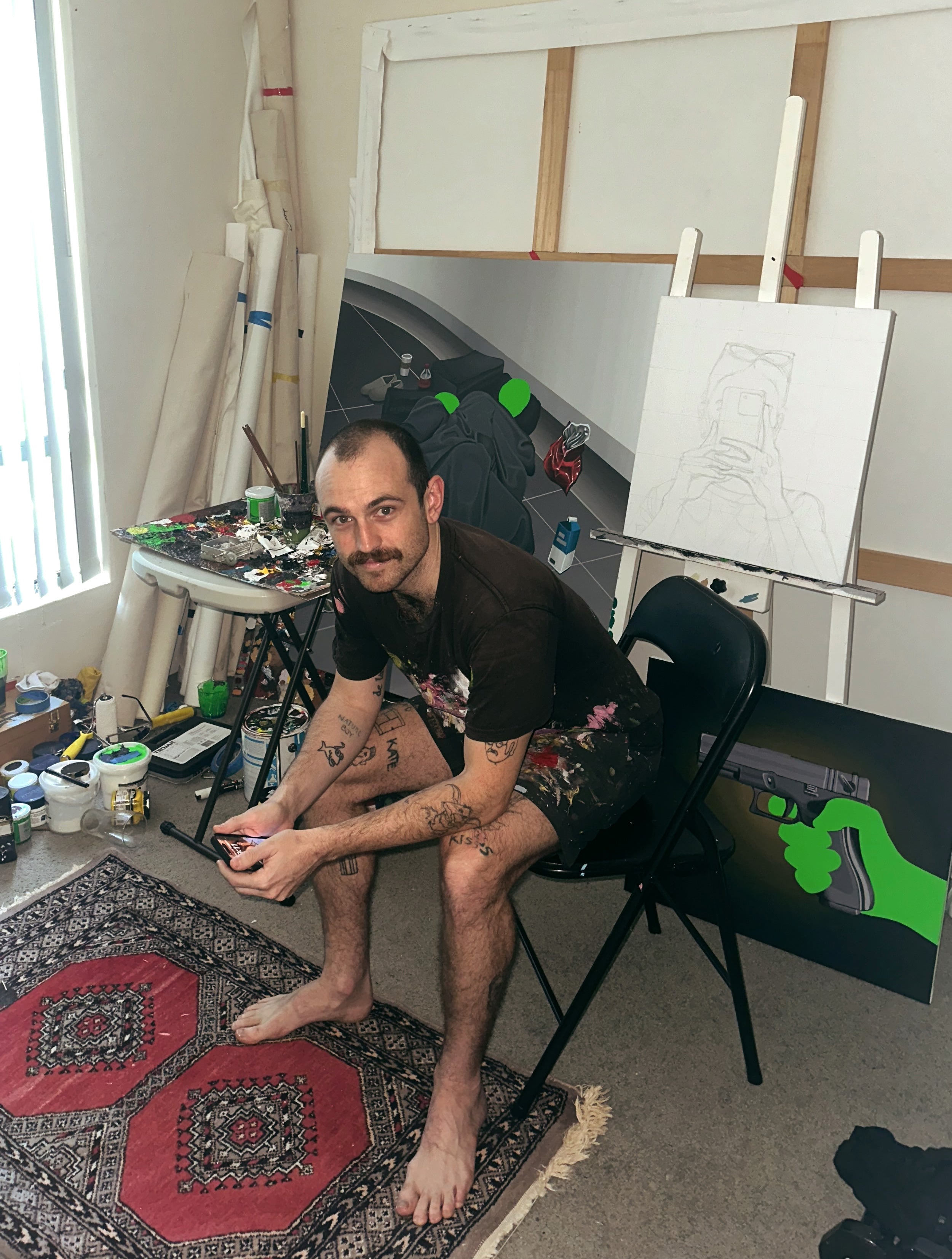


IN THE STUDIO: CHRIS DE LA MOTTE
in the studio: chris de la motte
In the lead up to our next solo exhibition at Wester Gallery, we caught up with artist Chris De La Motte in his studio.
Hey mate, let's kick things off, could you tell us a bit about yourself and your artistic journey and what led you to the style you work with today?
My name is Chris de la Motte, I’m a figurative painter working out of Sydney. I learnt to draw the human figure from a young age, taught by my father who is an architect and an excellent draftsman. Some-time after high school in 2015, I attended Sydney University (SCA) studying a Bachelor of Visual Art, with the intention of being a print maker. However, the print elective in second year was full, and I didn’t give myself much of a chance, failing to meet the deadline to make a choice. So, I was lumped into painting. I had done some rather crummy painting in my school days and other little bits and pieces, though didn’t see any merit in my attempts. The first week of second year study I walked into my painting studio and barely left for 2 years, I simply loved it. Since leaving university in 2019 the experience has been much the same, all my spare time and energy has been poured into my studio to churn out the best pictures I can.
Your art has a distinct voice that resonates with our audience, can you describe the moment or piece that you feel really defined your current artistic identity?
Sure. It was a painting I had been thinking about for a while. I was painting a lot of pop and had grown tired of it and moved into a kind of middle ground between abstraction and a graphic neo-classical painting. What I wanted to do was bring some renaissance/baroque figures and suspend them in a kind of vacuous non-space, as a kind of comment on a strictly formalist critique of art, though one key lesson I learnt in art school was never to simply suspend figures without grounding them in one way or another. So naturally I decided to paint a shadow under the figures. For one reason or another I thought ‘how would it look if the shadow was fluorescent?’, so proceeded to paint the shadow a fluro pink. The dynamic between the colours enthralled me and from an art history perspective it made a lot of sense, because for me the fluoro represented a kind of contemporary rupture of the painting plane. The painting is titled ‘chasing the dragon’ and was a part of the body of work preceding this one. Since then, the fluro motif has spread from merely shadows to the entire figures and I have stuck to predominantly fluro green as the driver, both for its brilliant colour dynamic against the primary colours and the literary qualities that specific colour possesses in the contemporary world.
Wester is all about the intersection of visual narratives and personal stories. How do personal experiences shape the themes you explore in your work?
I wouldn’t say personal experiences in the sense of a specific event or incident shape the themes of my work. My paintings are for me concerned with painting, great paintings and the great painters that came before me and in a non-literary way talking to the history and current landscape of painting. At the end of the day, I Iove painting, so I guess the experience of this love affair shapes the themes I explore. Certainly, there are literary qualities to my work and the narrative structure of them I find fascinating, and I hope the viewer does too, however this is secondary to the painting for me, as these interpretations can change over time or quite honestly on a whim.

We’re fascinated by the process as much as the product. Could you walk us through your creative process from concept to completion?
Hmm, it’s certainly not all that grandiose. Currently as I have a rather rigid theme with the fluoro green figures, basically I will think of a scene or see a certain image I think captures a certain period or group of society and then source image/s, either online or in public if possible. I can then edit and scale these up, map them onto a canvas and start painting. I prefer to source my own images, though for certain pictures I simply can’t.
We have always celebrated the diverse methods artists use. Are there any unusual techniques that might play a key role in your works?
To be perfectly honest, I can’t think of anything that is especially unusual in my painting practice. I guess it’s hard to say as I don’t really watch many other artists paint.
Inspiration can be found in the most unexpected places. Can you share an unusual source of inspiration that has surprised you with the impact it has had on your work?
Inspiration for me is something you earn while working. I can’t think of a specific time inspiration has reached out and grabbed my brush. The inspiration I get is a kind of unintentional discovery when working, applying paint in a certain way I hadn’t before, realising I can use a certain technique I hadn’t considered and I guess the pursuit of that discovery is inspiration enough for me to keep turning up every day to quite literally watch paint dry.
We often discuss the relationship between artist and space and people love to see inside an artists creative space. How does the physical space in which you create affect your output?
My studio is quaint. It’s about a 4x3 metre room in our apartment. Just big enough to fit a 2x2 metre canvas through the door and have enough room to paint it. I do like to paint large scale, though I am a little limited by the size of my studio, though I also like the cosiness of it, everything is basically within arms reach and I’m never more than a couple of metres from the canvas I’m working on. I think most painters will agree I miss out on the luxury of being able to back up a few more steps to take a look at the work from a distance, though for now I’m content in my little studio that could.
Many of the people that may come across our site and journal are artist themselves. Is there any advice you would give to someone just starting out in the art world?
Once you decide what you want to do, be it painting, sculpture, filmmaking etc, never forget that that’s what you do. The only thing that’s going to make your work any good is its immediate identification with what it is. If you’re a musician, make music with the sole purpose of sounding excellent, sublime even, if you’re a painter, make paintings with the intention they look incredible or supreme. All the rest comes in retrospect, no one cares what an artist has to say or who they are even if their work isn’t any good in the first place. I certainly don’t want to come off as if my work has lived up to this or ever will, but this is the goal, and even trying to achieve this is asking more than enough for any artist.
We like to highlight how an artist engages with their community. Could you describe a project or exhibition where you have interacted with the community or engaged viewers in an innovative way?
My canvas paintings have been up to this point only exhibited in gallery spaces. There certainly is a local, community element to this, and I really love meeting strangers who have come to the gallery because they are affiliated with it or basically it’s their local. I have been a part of some large-scale public art projects as a painter apart from my canvas works. I’ve painted 2 large scale indigenous murals in Darlinghurst and Erskineville, for Jason Wing and Maddie Gibbs, a large scale mural for the Aboriginal Design centre at the Al Faisal school in Austral and an apartment block in Waterloo for architect Richard Goodwin, which were a joy, not only to paint but see the effect large-scale murals like that can have on the local community, both the awe, the aesthetic revitalisation and the respect I felt being trusted to bring these important cultural works to fruition.
Sustainability and art are increasingly intersecting. How do you consider environmental or ethical factors in your practice?
Hmm, it’s a tough question. I think a lot of artists with great intentions create art with the purpose of spreading certain messages about the environment and the negative effects humanity has on the climate, which I think is certainly moral. though I’ve always seen art as a kind of selfish pursuit which runs counter to the kind of activism seen globally on such issues. I’m not convinced a painter, sculptor, musician, or whatever kind of artist can really do much for the net gain of the world in the fight against climate change sitting in their studios making music or moving clay and paint around. I’m sure there’s plenty of people trying to make a difference though I’m yet to see any decent results, there are also huge developments happening on this front in basically all other sectors and institutions on earth, so I’m not holding my breath waiting for an artist to solve the problem. I was made privy to the fact in art school that there is a whole movement of ethical painters who reject oil painting for its damaging effects on the environment and as a predominantly acrylic painter I take solace in the fact that I’m helping in my own minute way haha.

Art can often challenge or comfort. Do you aim for your work to provoke, soother, perhaps a bit of both? How do you balance these elements? And are they at the forefront when creating?
They are not at the forefront for me when creating, I am trying to capture the viewers’ attention and hold it for as long as I can. Marshall McLuhan said that this is the goal of any artist and I think that to be true. Though if I was to pick one it would certainly be to challenge the viewer. Challenge them to look at painting like they haven’t before but also with this recent series to see if I can get them to question what the human subject really looks like today as opposed to any other period in history.
In terms of evolution, where do you see your practice going in the next few years? Are there new mediums, or subjects you’re eager to explore?
I think my painting practice will certainly continue, I am about due for a change in tact stylistically so it’s hard to say what my paintings will look like in a year or two, having said that, they could look much the same, I am still quite enamoured of the interplay between the fluorescent paint and primary colours when I get the chance to bring them all in together. I have always loved film and did a bit of film making in school and university. If time permits, I’d love to do some filmmaking, what that looks like I’m not entirely sure just yet, though I’ve plenty of material in the very early stages.
Wester is very passionate about the stories behind the art. Is there a piece of yours displayed in this exhibition that has a particularly meaningful backstory? Could you share it with us?
The interpretation of my paintings I believe is quite open. There have been times where I may think a certain painting has a certain meaning, and while painting it or seeing it some time later change my interpretation of it, there has also been a time where a friend has told me their interpretation of one of my works and I liked theirs so much better than mine that it became my interpretation. So having said that I certainly don’t think this is fixed, though my interpretation of the painting ‘Oedipus at Colonus’ for me is interesting and in ways sums up the whole series. The series really is about displaying contemporary subjects with a mythological or deep historical spin on them, with the titles, to bring out the banality or impossibility of really understanding what people look like today from any other period in history. I was thinking about pageantry and the spectacle of contemporary society and landed on the Met Gala as a kind of modern mecca of prestige and a somewhat pagan religious experience. I was also thinking in the deep past and mythologically, what do these people represent(?), that are so fawned over by the masses. I picked a particularly extravagant looking dress while I was rifling through old red-carpet pictures taken at the Met Gala, I honestly couldn’t tell you who the subjects are. After I started painting it, I was going through different Greek gods/ess and who would be best to assign these figures too, then I changed tact and thought no, these people are worldly, and the masses have an interest in their goings on. The camera people in the background for me is a kind of haunting all too familiar intrusion on one’s privacy but in this scene, it’s welcomed, encouraged even. I finally decided to take Sophocles most famous characters Oedipus and Antigone as the namesakes for the figures. The idea for me of not only identifying these contemporary figures with the past I also love thinking about how Oedipus and Antigone would be received in the contemporary world. Would the folk of New York lament the arrival of such a duo, would this be a re-emergence of the embattled father and daughter in a kind of PR stunt, or would it make Antigone’s actions a kind of banality which were only ever means for her to wear this incredible dress and pose on this most prestigious of red carpets. It makes me question all manner of things and characters of the past and how they would be received today. Rick Roderick made a great observation which stuck with me: that is, if Jesus was alive today, he’d most probably have a Nike sponsorship.
The art world is coming a bit more collaborative. Is there an artist you would love to collaborate with, and what would you hope to create?
I’m not really interested in collaborating with any artists regarding painting. One of the reasons I am so interested in film is the collaborative side. I think film is one of the few arts that are truly collaborative, and I am keen to get into it in the not-too-distant future in any capacity really, whether behind the camera, in front or anything in between.
Finally, besides Wester, if you could have your next solo exhibition anywhere in the world, where would it be and why?
Again, great question, these aren’t easy. At this stage I don’t have a preference. Anywhere that will have me. I’m very active and in the coming years want to be exhibiting as much as I can. The fact that any gallery, Wester Included of course! has given me the chance to exhibit in their space is deeply humbling. I don’t plan on stopping painting anytime soon, so whichever gallery will have me next would not only be a journey but a privilege.
You can catch Chris' latest solo exhibition at Wester from Friday 10 May - 25 May, with the opening night reception Friday 10 May, 6pm - 8pm
